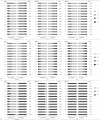Comparison of pathological characteristics between self-detected and screen-detected invasive breast cancers in Chinese women: a retrospective study
- PMID: 29713563
- PMCID: PMC5924684
- DOI: 10.7717/peerj.4567
Comparison of pathological characteristics between self-detected and screen-detected invasive breast cancers in Chinese women: a retrospective study
Abstract
Background: In China, there is insufficient evidence to support that screening programs can detect breast cancer earlier and improve outcomes compared with patient self-reporting. Therefore, we compared the pathological characteristics at diagnosis between self-detected and screen-detected cases of invasive breast cancer at our institution and determined whether these characteristics were different after the program's introduction (vs. prior to).
Methods: Three databases were selected (breast cancer diagnosed in 1995-2000, 2010, and 2015), which provided a total of 3,014 female patients with invasive breast cancer. The cases were divided into self-detected and screen-detected groups. The pathological characteristics were compared between the two groups and multiple imputation and complete randomized imputation were used to deal with missing data.
Results: Compared with patient self-reporting, screening was associated with the following factors: a higher percentage of stage T1 tumors (75.0% vs 17.1%, P = 0.109 in 1995-2000; 66.7% vs 40.4%, P < 0.001 in 2010; 67.8% vs 35.7%, P < 0.001 in 2015); a higher percentage of tumors with stage N0 lymph node status (67.3% vs. 48.4%, P = 0.007 in 2010); and a higher percentage of histologic grade I tumors (22.9% vs 13.9%, P = 0.017 in 2010).
Conclusion: Screen-detected breast cancer was associated with a greater number of favorable pathological characteristics. However, although screening had a beneficial role in early detection in China, we found fewer patients were detected by screening in this study compared with those in Western and Asian developed countries.
Keywords: Breast cancer; Chinese; Pathological characteristics; Screen-detected; Self-detected.
Conflict of interest statement
The authors declare that they have no competing interests.
Figures


Similar articles
-
Community-Based Breast Cancer Screening Using Digital Breast Tomosynthesis Versus Digital Mammography: Comparison of Screening Performance and Tumor Characteristics.AJR Am J Roentgenol. 2022 Feb;218(2):249-257. doi: 10.2214/AJR.21.26384. Epub 2021 Sep 15. AJR Am J Roentgenol. 2022. PMID: 34523954
-
A comparison of clinical-pathological characteristics between symptomatic and interval breast cancer.Breast. 2015 Jun;24(3):278-82. doi: 10.1016/j.breast.2015.02.032. Epub 2015 Mar 11. Breast. 2015. PMID: 25771080
-
Comparison of clinical and pathological characteristics between screen-detected and self-detected breast cancers: a Hong Kong study.Hong Kong Med J. 2016 Jun;22(3):202-9. doi: 10.12809/hkmj154575. Epub 2016 Mar 29. Hong Kong Med J. 2016. PMID: 27022189
-
Comparison between screen-detected and symptomatic breast cancers according to molecular subtypes.Breast Cancer Res Treat. 2012 Jan;131(2):527-40. doi: 10.1007/s10549-011-1836-0. Epub 2011 Oct 30. Breast Cancer Res Treat. 2012. PMID: 22042364
-
Favourable prognostic factors of subsequent screen-detected breast cancers among women aged 50-69.Eur J Cancer Prev. 2012 Nov;21(6):499-506. doi: 10.1097/CEJ.0b013e328350b0f4. Eur J Cancer Prev. 2012. PMID: 22273849 Review.
References
-
- Anderson BO, Yip CH, Smith RA, Shyyan R, Sener SF, Eniu A, Carlson RW, Azavedo E, Harford J. Guideline implementation for breast healthcare in low-income and middle-income countries: overview of the Breast Health Global Initiative Global Summit 2007. Cancer. 2008;113(8 Suppl.):2221–2243. doi: 10.1002/cncr.23844. - DOI - PubMed
-
- Chinese Anticancer Association Breast Cancer Society Clinical practice guidelines in breast cancer (Version 2007) China Oncology. 2007;17(5):410–428.
-
- Chinese Anticancer Association Breast Cancer Society Clinical practice guidelines in breast cancer. China Oncology. 2015;25(9):692–754.
-
- Chuwa EW, Yeo AW, Koong HN, Wong CY, Yong WS, Tan PH, Ho JT, Wong JS, Ho GH. Early detection of breast cancer through population-based mammographic screening in Asian women: a comparison study between screen-detected and symptomatic breast cancers. Breast Journal. 2009;15(2):133–139. doi: 10.1111/j.1524-4741.2009.00687.x. - DOI - PubMed
-
- Crispo A, Barba M, D’Aiuto G, De Laurentiis M, Grimaldi M, Rinaldo M, Caolo G, D’Aiuto M, Capasso I, Esposito E, Amore A, Di Bonito M, Botti G, Montella M. Molecular profiles of screen detected vs. symptomatic breast cancer and their impact on survival: results from a clinical series. BMC Cancer. 2013;13(1):15. doi: 10.1186/1471-2407-13-15. - DOI - PMC - PubMed
LinkOut - more resources
Full Text Sources
Other Literature Sources

